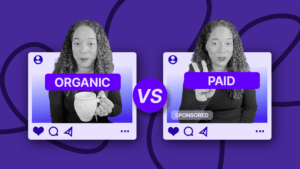How To Build A Winning UGC Strategy From Scratch
With over 7 years of e-commerce experience, Agne has mastered the balance of creativity and performance. From guiding social media strategies to crafting high-converting ads, she’s all about results.

If you want your business to succeed, you have to build trust. Customers need to know you will deliver on their expectations.
Traditionally, companies did this with conventional marketing. However, today’s audiences want the authenticity of peers to establish brand relationships. And that’s where user-generated content (UGC) shines.
UGC is valuable for every company because it permits a deeper connection with audiences. Prospective customers want to see how their peers respond to your products and services, instead of relying solely on your advertising. The more authentic the UGC is, the more impactful it becomes.
Statistics supporting the use of UGC are everywhere. For example, YouTube-based UGC videos get ten times more views than those made by brands. UGC reduces cost-per-click by 50% while 77% of shoppers are more likely to buy a product discovered via user-generated content than elsewhere.
With these data in mind, this guide explains how to build a winning user-generated content strategy from scratch. We look at how to choose the right platform, define your UGC goals, and improve content curation. By the end, you will know how to use this marketing strategy to boost business success.
Define Clear UGC Goals
First, consider your goals for any upcoming UGC campaign. What do you want to use it for?
Most brands use UGC to boost trust and authenticity. Plugging into audiences’ peer networks increases consumer impact. Shoppers trust social media influencer messages more than commercials, leading to higher brand acceptance and loyalty.
Related to this, brands also leverage UGC for engagement. Creating and sharing UGC content improves the quality of brand-customer communication compared to conventional advertising. For example, prospects can’t comment on conventional website banner ads – no mechanism exists. However, they can comment on the Facebook or YouTube pages of the influencers they follow, sharing their opinions. More importantly, brands or their representatives can respond. Customers feel like they are having a real interaction.
Brand visibility and reach are another reason for using UGC. Without it, companies (like startups) can find it challenging to make headway online during the early days of their enterprises. There is so much competition that it is challenging to progress. UGC bypasses much of this, getting brand-relevant content in front of willing audiences rapidly.
Lastly, many firms use UGC because it is affordable. It is inexpensive compared to other methods, like pay-per-click and conventional sponsorships.
Choose the Right Platforms for UGC
Manual UGC is possible, but also challenging. It takes time to connect with influencers, gather content, curate it, and publish it. Because of this, UGC platforms are becoming more popular. These consolidate these activities into a single app or website, letting you do everything in one place.
Billo is an example of a UGC platform in action. It helps streamline the UGC marketing process by:
- Vetting creators, checking their suitability for commercial applications
- Providing a selection of over 5,000 influencers ready to go on-demand
- Creating tailored, customized briefs for UGC ads that creators can follow
- Delivering various UGC types from promotions to reviews
- Acquiring UGC content to deploy rapidly
- Scaling UGC efforts across product pages and categories without ballooning costs
- Matching creators to brands through filters, such as age, interests, brand fit, and style
- Focusing on the return on investment (ROI) of UGC efforts by providing analytics tools
- Optimizing UGC videos for various platforms, including TikTok and Meta
When choosing a platform, ensure it offers all these features. Check it vets and filters influencers to avoid individuals who generate content that doesn’t align with your brand message.
Also, ensure that the tool scales properly. Don’t choose a platform that limits the UGC you can generate for campaigns as a growing business.
Some UGC platforms have smaller creator sizes than others. The former are sometimes newer, but they may also be of higher quality.
Many platforms will claim they can access “over 100,000 creators” but they don’t always vet them. Because of this, you can sometimes get poor or unsuitable matches. By contrast, those with fewer influencers on their books, like Billo, often offer higher quality. More curation by the platform’s team often means fewer dead-ends.
Finally, look for platforms that offer support and guidance. Every Billo client receives a success manager included in the price, a professional to help them use our tools effectively. These individuals can answer questions and modify UGC campaigns to increase their likelihood of success.
Plan and Curate Content
Planning and content curation are essential elements of any UGC strategy. Getting these right lets you deliver marketing that aligns with your branding. But what do you need to do?
Select The Right Social Media Platform
Start by choosing a social media platform that works for your business. UGC is effective on all of them but your audience may concentrate on specific sites (i.e. Instagram).
UGC campaigns can take the form of:
- Video challenges on TikTok
- Quotes, stories, and photos on Instagram
- Video posts on Facebook
- Company news on LinkedIn
- Reviews on X
- Content for your website
Consider where your audience will see this content and if the chosen platform can support the UGC format you want to promote. For example, Instagram is more visual than X.
Tell Customers What You Want
Next, be explicit about the type of UGC you want your audience to create. Providing clear instructions reduces the time needed to curate their work.
If you use a UGC service, provide comprehensive, easy-to-understand briefs. Don’t bombard creators and influencers with pages of instructions that are hard to assimilate. Keep everything as simple as you can while conveying the key points.
Some brands benefit from creating guidelines explaining how audience members should generate qualifying UGC. These should balance generating authenticity and avoiding anything that could denigrate the company name. Others make their requirements more specific, such as whether the creator should create text, video, or images. Ultimately, it’s your choice.
Encourage UGC from Your Audience
If you reach out to customers directly, offer them something in exchange for their UGC content. For example, you could:
- Provide them with a fixed-value shopping voucher
- Enter them into a prize draw
- Feature them on your official brand feed
- Provide a behind-the-scenes tour of your operation
During this process, focus on building a community. Creating a core network develops more connections and draws more individuals toward your enterprise.
UGC platforms can help you manage creators and participating audience members. You can host events to bring everyone together or use platform tools to communicate regularly with these individuals. The deeper the relationships you form, the more likely people are to contribute.
Moderate Your UGC
The next (and often most time-consuming) step is moderation. Curating UGC so that it reflects your requirements is essential.
Some brands allow creators to upload UGC directly (particularly through platforms), while others require it to go through an editing stage first. Usually, the latter option is the safer one. Editing helps to catch issues before they can adversely impact your brand.
Here’s what to watch for:
- Security issues. Start by assessing whether the UGC presents security issues for your brand, the creator, or any third party. Check it doesn’t contain any personal information or company secrets.
- Calibration issues. Next, ensure the UGC fits the intended platform. Calibration issues (such as using the incorrect aspect ratio) can make it less compelling when you upload it.
- Consistency issues. Check the UGC matches your brand requirements, including the style and tone. Use color filters and other tools to adjust the content to match your intended platform or website.
- Create variations of the content. Use editing to create content derivatives for other channels. For example, you could make a longer video for YouTube and chop it up into shorter segments for TikTok and Instagram. Pay special attention to things like the video orientation and aspect ratio. Cropping media and choosing the right file formats can help tremendously.
- Edit contributions. Finally, you may need to edit UGC contributions directly. Most users aren’t professional video or image editors, so they may not generate a high standard immediately. Enhancing the audio, changing the lighting, trimming sections, or removing shadows are all techniques possible on today’s advanced software.
Measure the Success of Your UGC Campaign
Measuring the success of your UGC campaign is challenging unless you use a platform that tracks key metrics for you, like Billo. Knowing how well your user-generated content performs provides insights into how much you should invest in it or if you should change tack and try something else.
You can measure the success of a UGC campaign using:
- Brand mentions – the number of times people mention your brand after you launch your UGC campaign
- Return on investment (ROI) – a critical metric telling you how much money your campaign generates per dollar you put into it
- Customer sentiment – some tools allow you to measure customer sentiment, seeing whether UGC improves attitudes toward your brand
- Conversion rate – the percentage of prospects who later become customers after you interact with them online
- Reach – the number of people who see your UGC content
- Cost per acquisition (CPA) – how much it costs you to attract each purchasing customer
- Website traffic – the number of people landing on your pages because of UGC
Ultimately, it is up to you which metrics you choose. A combination is probably best. Pick metrics that align with the UGC goals you set in the first section of this guide. Then, use these objective measures to see if you are moving toward the target.
Examples of Successful UGC Strategies: What Works?
UGC seems new, but numerous brands are already proving it works. Their examples show which UGC practices to use and how to leverage them for massive online success.
Crocs
Crocs is a footwear brand that’s become increasingly well-known for its unique slippers/shoes. The company’s present fame is the result of some clever marketing strategies, particularly UGC.
Crocs went viral with its #MyCrocsEra hashtag, inviting people from across the globe to share images of their shoes. The brand actively encouraged customization, getting people to treat wearing Crocs as an artistic exercise. In so doing, the brand generated millions of hits for its social media pages and gave some customers their 15 minutes of fame.
Cancer Research
Cancer Research is a UK-based charity that aims to improve the lives of people with the disease. In 2014, it launched the No Makeup Selfie campaign for women and asked them to get their friends to do the same. The marketing drive asked participants to donate £5 to the charity, leading to more than $10 million of donations in just six days.
Calvin Klein
Calvin Klein is another brand that’s used UGC successfully in the past. The label’s #MyCalvins was one of the most successful in history with celebrity endorsements from Kendrick Lamar, Justin Bieber, and Kendall Jenner.
The basic concept was simple: customers would put on their Calvin Klein clothing and then post pictures of themselves wearing it on social media. The label would then curate the best photos and add them to its website.
For Calvin Klein, it was a stroke of genius. The company drove engagement among its audience and received free photographs for its site in exchange, helping it advertise its wares and appeal to a wider audience.
LEGO
LEGO is another brand that benefits from UGC. The toy blockmaker has a massive social media following globally and is always looking for new ways to engage its audience.
LEGO Ideas was one such effort. Launched in 2015, it asked customers to develop new LEGO models the company would later make a reality. Participants had to gain the support of 10,000 people for the company to build their ideas and sell them to the public.
This marketing drive was clever because it injected creativity into LEGO’s designs. Instead of getting in-house product developers to come up with concepts, it tapped into the genius of the crowd. Moreover, it put a mechanism in place to ensure that only the most popular ideas succeeded. If people were willing to vote for a specific idea, it also meant that they were likely to buy it.
Continue learning:
Creative Manager
With over 7 years of e-commerce experience, Agne has mastered the balance of creativity and performance. From guiding social media strategies to crafting high-converting ads, she’s all about results.

Authentic creator videos, powered by real performance data
22,000+ brands use Billo to turn UGC into high-ROAS video ads.
Common UGC Brief Mistakes Brands Still Make in...
A vague or overpacked brief derails campaigns before they start, [...]...
Read full articleOrganic UGC vs Paid UGC: How Top Brands Drive Gr...
More brands are turning to user-generated content (UGC) to fuel [...]...
Read full articleOrganic UGC: How to Turn Native Creator Posts in...
Short-form feeds spotlight content that feels natural, not like ads. [...]...
Read full article



